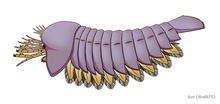Sanctacaris
| Sanctacaris Temporal range: Middle Cambrian
| |
|---|---|

| |

| |
| Scientific classification | |
| Kingdom: | Animalia |
| Phylum: | Arthropoda |
| Subphylum: | Chelicerata |
| Order: | † |
| Family: | † |
| Genus: | †Sanctacaris Briggs & Collins, 1988 |
| Species: | †S. uncata
|
| Binomial name | |
| †Sanctacaris uncata Briggs & Collins, 1988
| |
Sanctacaris is a Middle Cambrian [1] arthropod from the Burgess Shale of British Columbia. It was most famously regarded as a stem-group chelicerate, a group which includes horseshoe crabs, spiders and scorpions, although subsequent phylogenetic studies have not always supported this conclusion.[2] Its chelicerate affinities regain support in later observations,[3][1] alongside the reassignment of Habelia optata as a sanctacaridid-related basal chelicerate.[1]
Sanctacaris specimens range from 46 to 93 mm in length.[4] The head bears five pairs of grasping appendages (corresponding to chelicerate's pedipalps and walking legs) and a sixth pair of posterior appendages (correspond to horseshoe crab's chilaria).[4] The grasping appendages each bear an antenna-like exopods.[3] There are 11 body segments, with the former 10 each bearing a pair of biramus appendage with flap-like exopod and reduced leg-like endopod. There is a broad, flat paddle-like telson.[4]
Originally Sanctacaris was called informally 'Santa Claws'. Its Latin name translates as "saintly crab".[5] Unlike most other Burgess forms, Sanctacaris is not present in Charles Walcott's 1909 quarry and was discovered at a different level by Desmond Collins in 1980–1981.[5]
References[]
- ^ a b c Aria C, Caron JB (December 2017). "Mandibulate convergence in an armoured Cambrian stem chelicerate". BMC Evolutionary Biology. 17 (1): 261. doi:10.1186/s12862-017-1088-7. PMC 5738823. PMID 29262772.
- ^ Budd GE, Jensen S (May 2000). "A critical reappraisal of the fossil record of the bilaterian phyla". Biological Reviews of the Cambridge Philosophical Society. 75 (2): 253–95. doi:10.1017/s000632310000548x. PMID 10881389.
- ^ a b Legg DA (December 2014). "Sanctacaris uncata: the oldest chelicerate (Arthropoda)". Die Naturwissenschaften. 101 (12): 1065–73. doi:10.1007/s00114-014-1245-4. PMID 25296691.
- ^ a b c Briggs DE, Collins D (August 1988). "A Middle Cambrian chelicerate from Mount Stephen, British Columbia" (PDF). Palaeontology. 31 (3): 779–798. Archived from the original (PDF) on July 16, 2011. Retrieved April 4, 2010.
- ^ a b Briggs DE, Erwin DH, Collier FJ (1995). Fossils of the Burgess Shale. Washington: Smithsonian Institution Press. ISBN 1-56098-659-X. OCLC 231793738.
External links[]
- "Sanctacaris uncata". Burgess Shale Fossil Gallery. Virtual Museum of Canada. 2011.
- Prehistoric chelicerates
- Burgess Shale fossils
- Fossil taxa described in 1988